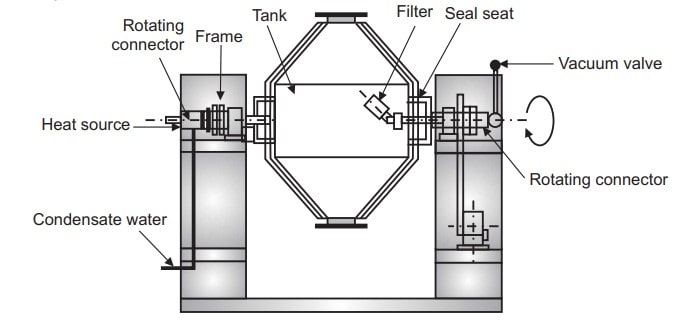Mixing is a common process step in the manufacture of products for industries such as healthcare, food, chemical, cosmetics, detergents, fertilizers, and plastics. The double cone blender (DCB) is used to produce a homogeneous solid-solid mixture.
Table of Contents
Principle of Double Cone Blender
Double cone blenders are most often used for dry blending of free solids. The solids being blended in these blenders can vary in bulk density and percentage of the total mixture. The matter being blended is constantly intermixed as the double cone rotates. The normal cycle time is 10 minutes and can be more or less depending upon the complexity of the material being mixed.
Construction of Double Cone Blender
The main body of this blender consists of two cone-shaped sections welded at their bases to a central cylindrical section. The axis of rotation is perpendicular to the cone axis and passes through the cylindrical section. The driving motor is located at one of the two lateral supports holding the blender body. The double cone blender is made out of stainless steel. All welding is done by Argon Arc Process. This is totally mirror polished from inside and outside. Unit is mounted on a mild steel / stainless steel stand fitted with ball bearings. It is available in capacity of 20 L to 3000 L. The conical shape at both ends enables uniform mixing and easy discharge. The cone is statically balanced which protects the gearbox and motor from any excessive load.

A suitable size butterfly valve at one end of the cone is provided for material discharge and a hole with an openable cover is provided at other ends of the cone for material charging and cleaning. The driving arrangement consists of a motor through a reduction gearbox and stainless steel baffles which are provided inside the blender. It has variable speed options available. Safety railing along with limit switch and platform are optional features for bigger models. Ancillary provisions include a facility for the incorporation of a liquid spray system to introduce liquids in spray form during the process. The unit can be equipped with an automated loading system for introducing powders and granules into the blender body by means of a vacuum unit with self-cleaning hoses. It includes a product receiving hopper with an automated self-cleaning filter; as well as a control panel for the unit. The loading/discharge can be carried out with pneumatically actuated retractable hermetic bellows.
Working of Double Cone Blender
Powdery or granular materials are fed into the double cone containers using a vacuum intake system or manual feeding. The continuous rotation of the containers makes the material move in a complex and forceful manner to achieve uniform mixing. The conical shape at both ends contributes to uniform mixing and easy discharge. Depending upon the characteristic of the material, paddle-type baffles can be provided on the shaft for better mixing, uniform blending, and de-agglomeration. A dust-free bin charging system ensures minimum material handling. The solids are introduced into the blender through the loading aperture. The mixing takes place axially, as a result of the powder bed moving through the different sections. Mixing is thorough but it depends on the rotating speed. The mixture is discharged through a hermetically closing butterfly valve which is operated manually or automatically. The blender provides efficient mixing actions when loaded at 50 % of its volume. The effective volume for optimum homogeneity is between 35-70% of gross volume.
Advantages
- DCB is an efficient and versatile mixer blender with closed container providing good product rolling and cross mixing.
- The ‘Slant’ design (off center) and conical shape at both ends enables uniform mixing and easy discharge.
- It performs mixing, uniform blending and de-agglomeration functions.
- The cone is statically balanced which protects the gear box and motor from any excessive load.
- Powder loading and discharge are through separate opening.
- Depending upon the characteristic of the product, paddle type baffles can be provided on the shaft for better mixing.
- Contact parts are made of S.S.304 or S.S.316 preventing corrosion and product contamination. It has dust free bin charging system that ensures minimum material handling.
- Additional features such as spay system, loading system, receiving hopper, flame proof electrical fittings can be fitted.
Disadvantages
- DCB is not suitable for fine powders.
- Particles with wide variation in size such as fine and large particles cannot be mixed efficiently due to low shear exhibited in this equipment.
- It requires more space and are not suitable for installation in rooms with low ceiling heights.
Appliations of Double Cone Blender
- The DCB are useful for mixing dry powder and granules for tablets and capsules formulations.
- It is used for dry granules sub lots mixing to increase the batch size at bulk lubrication stage of tablet granules.
- It can be suitable for dry powder to wet mixing.
- It can be used for pharmaceutical, food, chemical, cosmetic products etc.
- It is suitable for mixing highly flowable powdery and granular materials, with superior mixing quality.
- It can be suitable for the material mixing in food, essence, dye, chemical, plastic, rubber industry.
- It is suitable for medical intermediate, flavouring, graphite, coffee powder, iron powder whose specific gravity is under 7 g/cm3 that has certain fluidity with the liquid content under 10%.
Mechanisms of mixing